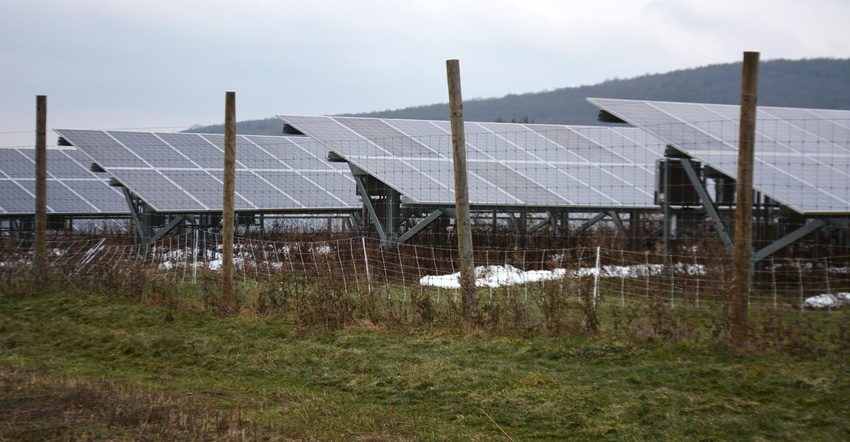
Thousands of acres of farmland could be transformed into large-scale solar installations over the next decade.
Pennsylvania is eyeing the potential of 80,000 acres converting to large-scale solar installations by 2030, when the state hopes to have 10% of its overall in-state electricity come from solar.
New York state’s goal is getting 70% of its electricity by renewables by 2030, including 6,000 megawatts of solar by 2025.
Tom Murphy, director of Penn State’s Marcellus Center for Outreach and Research, says there are many reasons for it, from governmental policies calling for more renewable energy to cheaper solar technology. But there’s another side to the story: the loss of farmland to solar projects.
Eric Zuber of Byron, N.Y., farms 3,500 acres and milks 2,500 cows. Forage is a big part of his cows’ diet — 53% of the diet — while the rest is grain that he buys in.
“The feed bill is the biggest expense, by a long shot,” he says.
He leased some of his poor ground 16 miles away in the town of Sweden to a solar installation. He’s since sold the ground and is hoping to buy more ground closer to the dairy. But his options to buy land might become more limited.
Close to his farm is the Next Era/Excelsior Energy Center project, a 280-megawatt solar installation that’s in the development stage and will take up 2,000 acres.
Zuber leases 220 acres within the project’s boundaries and has been doing so for 40 years. “I grow corn, wheat and hay on it, and spread a lot of manure on it,” he says.
He doesn’t begrudge the landowners who want to lease the land, nor does he begrudge anyone else for wanting to do the same thing.
But Zuber, who also is a town councilman, is worried about the amount of farmland that might be lost and whether it will be worth it.
“My basic concern is economics. Why are we doing it? These smaller solar things where you put it on the house, or on the side of the house, they make sense,” he says. “When they start these 2,000-acre projects and they take prime ag land, it makes no sense.”
“We can’t do it if we're going to be in the dairy business,” Zuber adds. “If we’re going to be in the dairy business, where are we going to go with the manure? Not every farmer will allow manure on their ground.”
“The last thing this country can sell and export is ag products,” and losing that would be devastating, he says.
Stacy Richards, a county commissioner in Union County, Pa., doesn’t want to see large-scale solar in her county either, especially if it’s on productive farmland.
Richards, who has a background in developing federal and state energy policy, has been following utility-scale solar development for years. She says farmland is a magnet for large-scale solar developers because the land has already been cleared, making solar installations more economical to install.
In most cases, she says, older farmers without heirs or family members who want to farm are the ones signing the leases.
“We’re really quite concerned about large-scale utilities,” she says. “It is mining energy, essentially, and you’ll be replacing one economy with another.”
Unless the farm has a preservation easement or other type of easement that prevents it from getting developed, Richards says there is little a government can do to stop a landowner from leasing their land.
So, the county is educating farmers on solar leasing. The Union County government has a website dedicated to solar leasing, including lease documents, videos and other presentations by experts, and FAQs.
Richards hopes that by educating farmers about solar leasing that they’ll think twice before signing a contract.
“The development of large-scale solar farms on productive agricultural land in Pennsylvania and throughout rural America is having a significant impact on rural land use, its ecosystem, and is disrupting local rural economies,” she wrote in an email. “A several-hundred-acre utility-scale solar farm is being constructed in Northumberland County’s East and West Chillisquaque townships, which abuts Union County. The utility-owned Talen solar is being constructed in neighboring Montour County.”
There is a “need to educate communities about the economics and land-use impacts of utility-scale solar farms prior to the permitting of these industrial facilities,” she added.
About the Author(s)
You May Also Like






